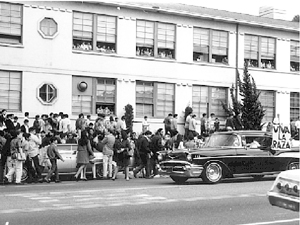Fight Back!: What kind of community organizing did you do?
Carlos Montes: We first took on the issue of police brutality.
The East L.A. sheriffs were notorious for their brutality, especially against Chicano youth, which I experienced cruising Whittier Boulevard on the weekends with hundreds of other youth.
We were the first to lead a protest at the East L.A. sheriffs station to protest the killing of youth at the station in 1967.
We also started working with the car clubs in East L.A. to defend them against police abuse.
We opened a local cultural center in East L.A., The Piranya Coffee House, where we held youth meetings and cultural programs.
It became one of the meeting places for the Brown Berets.
We also started working on the problems of the bad school conditions and the racist educational system.
Our schools were old and in bad condition, with high drop out, or push out, rates and racist administrators and teachers.
Over time, we started agitating for bilingual education, better school conditions, Chicano studies and more Chicano teachers.
We attended community, school and youth meetings to raise demands for better educational and school conditions.
This finally led to the historic East L.A. Blowouts in March of 1968, where thousands of high school Chicano youth walked out of the four predominantly Chicano high schools in the Eastside over a two week period.
The Brown Berets were the first to run in to the high schools, yelling, �Walk out! Walk out!� To get the blowouts started, me and James Vigil (a k a Mangas Coloradas) ran into Lincoln High School on the first day to kick off the walkouts.
We then went on to Roosevelt High School and the other schools.
We also supported the land movement in New Mexico of the Chicano small farmers and ranchers.
They fought to recover the land stolen by the rich Anglo ranchers and the U.S. federal government.
We supported the United Farm Workers� struggle for union recognition and better working conditions.
We marched with the first Rainbow Coalition in the Poor Peoples Campaign in Washington D.C. in the summer of 1968.
We were at the first historic Chicano Youth Liberation conference, where the Plan Espiritual de Aztlan was formulated in Denver, Colorado.
We also organized the first Chicano Moratorium against the Vietnam War in December 1969. This led to the historic national Chicano Moratorium march and rally against the Vietnam war on Aug. 29, 1970, where over 20,000 Chicanos protested the high casualty rate of Chicanos in Vietnam and demanded self-determination at home in the Southwest.
Fight Back!: What were major successes?
Carlos Montes: We exposed police brutality. Back then, some people tried to deny it existed.
We were part of building the Chicano movement for self-determination, which raised the slogan of Chicano Power.
It also started the movement for cultural awareness and pride in our Chicano history in the Southwest and Mexico, and our culture and language.
The blowouts were historic because it was the fist wave of mass actions by Chicanos in the urban barrios of the late 1960s.
We eventually won bilingual education, Chicano studies, better school conditions and Chicano teachers and administrators.
The mass anti-war demonstrations were part of the movement that eventually forced Nixon to pull out of Vietnam.
We also opened the doors for affirmative action in higher education and political representation.
